Conversation Panel
The conversation panel on Webex Engage displays intuitive threaded conversation views, delivery receipts, and relative timestamps, allowing agents to be more efficient. All chat-related activity logs are also presented to add additional context and history to the chat.
This section covers below topics:
- Alias Chat ID
- Flag Chats
- Chat Notes
- Tag Chats
- Transfer Chat
- Trigger Event
- Email Transcript
- Putting a Chat on Hold
- Message Box
- Close a Chat
- Map Preview
- Floating Button
- Carbon Copy and Forwards on email channel
Alias Chat ID
Webex Engage allows the agent to mark a chat with an Alias ID to maintain a seamless correlation with the existing support system. The agent can also search for a chat with the Alias Chat ID on the Search page. This Alias Chat ID must be unique within a team.
Follow these steps to create an Alias Chat ID:
- Click the Add icon adjacent to the Chat ID in the Conversation Panel.
- Enter the required Alias Name and click Check mark. A confirmation message is displayed.
Note
The alias name features as an additional column in the Dashboard (Unanswered Messages by Agent Table) and in all the Reports such as Sent Message Transactions, Unanswered Messages by Agent, Sent and Received Message Logs, Tagged Chats in addition to the regular Chat ID (generated by the platform).
Flag Chats
Webex Engage enables the agents to Flag chats with a specific color in the conversation panel. Once set, the Flag appears on the chat tile under agent’s My Chats’ section. Each color of the flag denotes a category that is configurable by the team manager. The team manager can even Enable or Disable a flag of specific color.
For more information about configuring flags for a team, please visit the section Flag under Chat Panel Settings.
Follow these steps to flag a chat:
- Click Flag icon adjacent to the Chat Notes in the conversation panel.
- Select the flag from the drop-down menu based on the business need.
- The selected flag appears on the chat tile under agent’s My Chats section:
To clear a flag for a Chat ID, click on the Flag icon adjacent to the Chat Notes in the conversation panel to display a drop-down menu, and click Clear Flag.
Chat Notes
Webex Engage enables the agents to add notes related to a chat. These notes are saved and are available even after the chat is Transferred, Closed, or Picked up by other agents.
Follow these steps to add a chat note:
- Open one of the chats from My Chats section to view the chat thread of the customer.
- Click Chat Notes icon to display the internal chat notes thread. The icon acts as a toggle switch to navigate between the conversation window and the internal chat notes window.
- Enter the Notes in the Send Message box and click Add. These notes are visible only to the Agents/Admins.

If a chat already has notes, a red dot appears on the Chat Notes icon as shown in the above image.
Tag Chats
Webex Engage enables agents to Tag a chat with Tags that are predefined for the team. Agents tag a chat based on the context of the chat conversation. These tags can be later used by the team managers for reporting purposes. These can be configured by the team manager as per the business need.
Follow these steps to tag a chat:
- Click Tag icon on the conversation panel of the chat.
The list of tags configured for this team will display on the screen. - Click Add icon beside a tag. The count of the tags added is displayed as a badge on the Tags icon on the top pane.
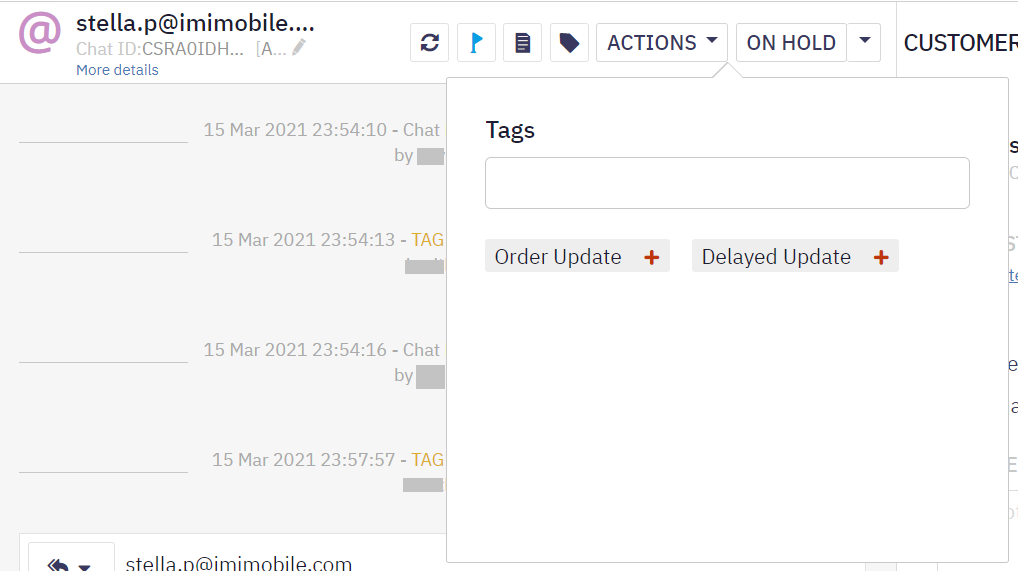
Trigger Event
Webex Engage can be easily integrated with external systems to ensure customer records are synchronized in real-time. This can be achieved with the help of events. The agents can trigger these events when they are in the middle of a conversation with the customer.
Follow these steps to trigger an event
- Click Trigger Event under Actions drop-down list on the conversation panel.
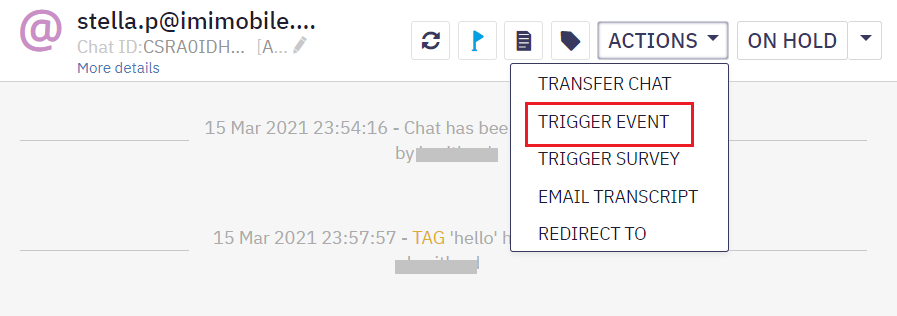
- Select the required event from the pre-configured list of events, and click Trigger.
- If the event has been configured to accept input parameters from the agent, enter the required parameters and click TRIGGER.
- Once the event is triggered, an announcement is appended to the chat conversation history.

- Agent can also view the response (if any) returned when the event is triggered.
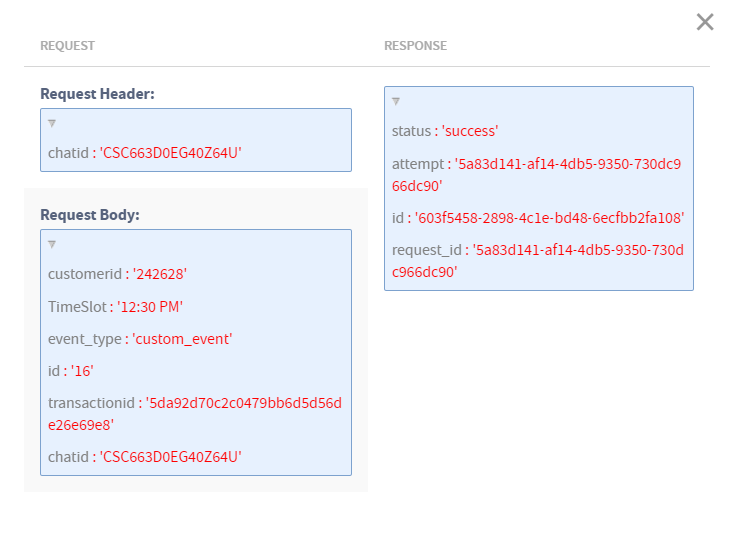
Putting a Chat on Hold
Webex Engage allows agents to quickly put chats awaiting customer reply on hold for a considerable amount of time and continue to service other pro-active customers waiting or the ones in the common queue.
Once the inactive customer messages, the chat is assigned back to the previous agent or team’s queue based on auto-assign to last handled agent setting for the team.
Note:
The chats that are On-Hold are not closed but they are in active status.
Follow these steps to put a chat on hold:
- Click On Hold option on the conversation panel.
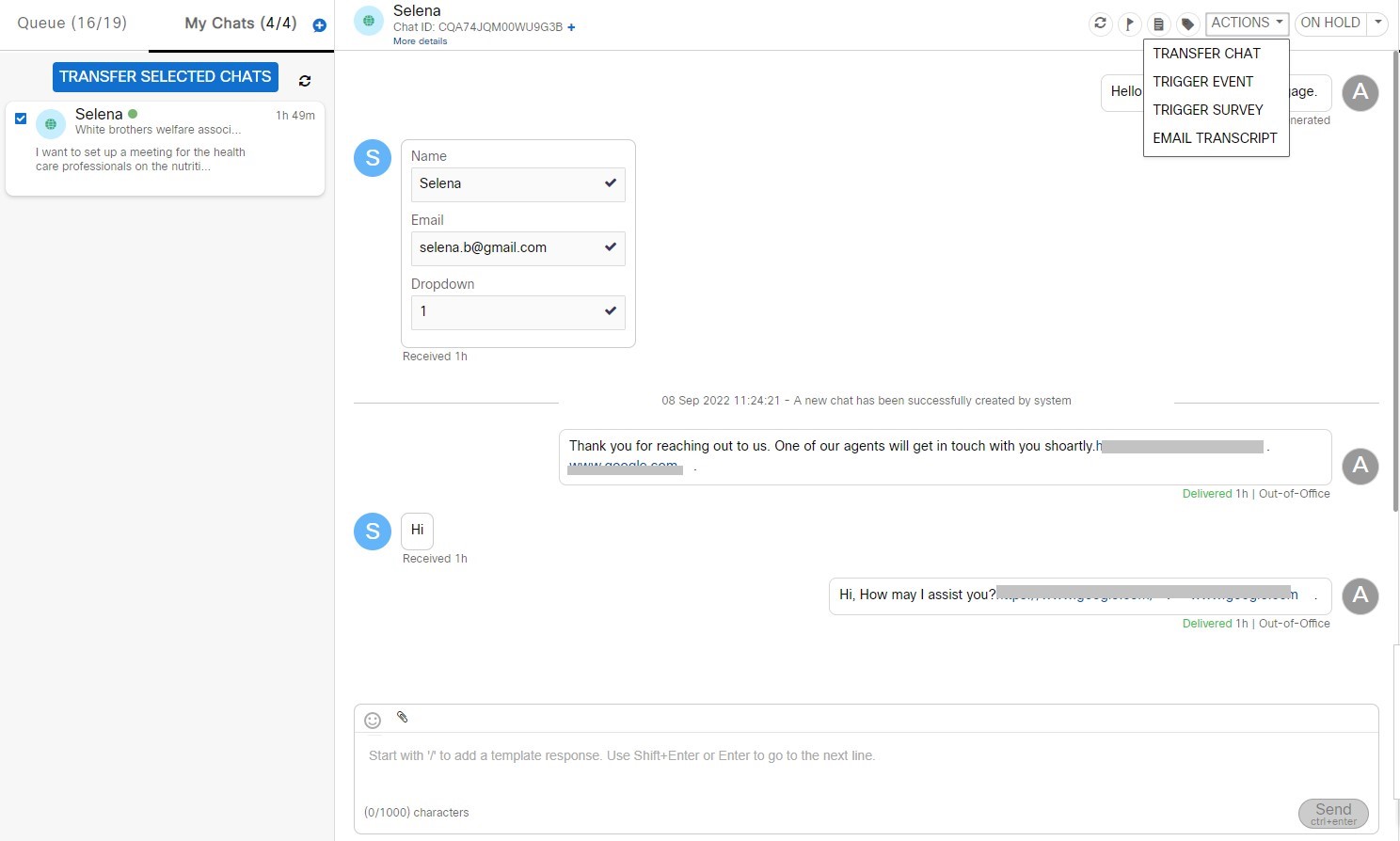
- A confirmation pop-up window appears, click YES .
- The chat appears under the ‘Recently put on hold’ section in the ‘Search’ page.
The agent can anytime choose to pick the chat from this list.
Note
If Auto on hold setting is enabled for the team, any chat awaiting customer’s response will automatically be put on hold based on the threshold configured by the team manager.
Email Transcript
The chat transcript can be sent to other team members or team agent.
Follow these steps to send an email transcript:
- Select Email Transcript under Actions drop-down list on the conversation panel.
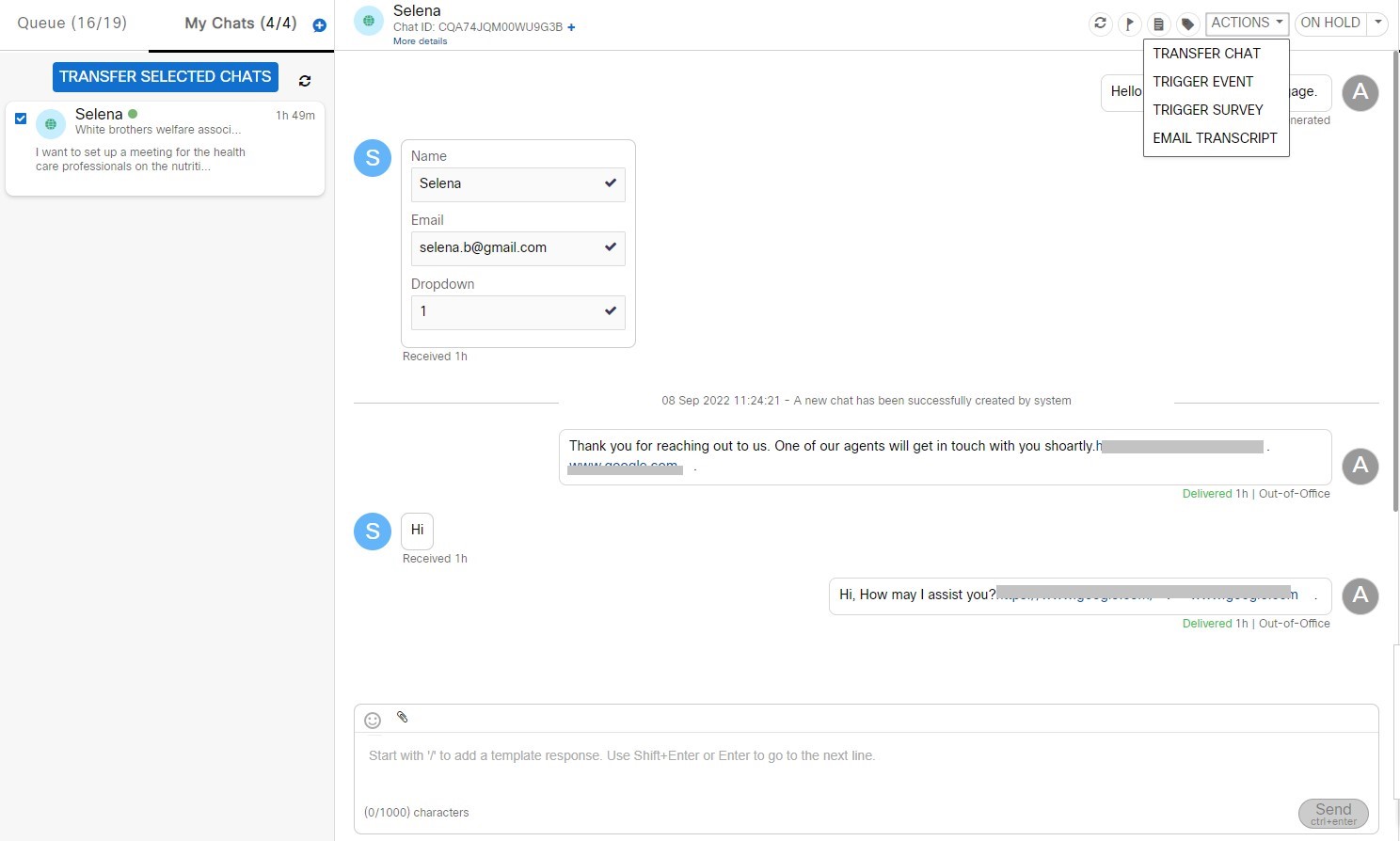
- Enter the Email IDs of the group members. You can enter up to Five Email IDs.
- Click Send.
Note:
To ensure the business’s privacy and to comply with data protection regulations, from now on Email Chat Transcripts requested on Webex Engage's Livechat widget will only contain the actual inbound messages and outbound messages along with the corresponding time stamp (omitting announcements).
Information of the agent(s) such as name, email address, etc., and other system messages will not be included in the transcript.
Redirect To
Redirect to feature helps agents forward an email to other assets at any point in time during a conversation. This feature allows agents to address the chats effectively by routing them to the right asset, thus reducing the time required to close them.
Follow these steps to redirect an email:
- Select Redirect To under Actions drop-down list on the conversation panel.
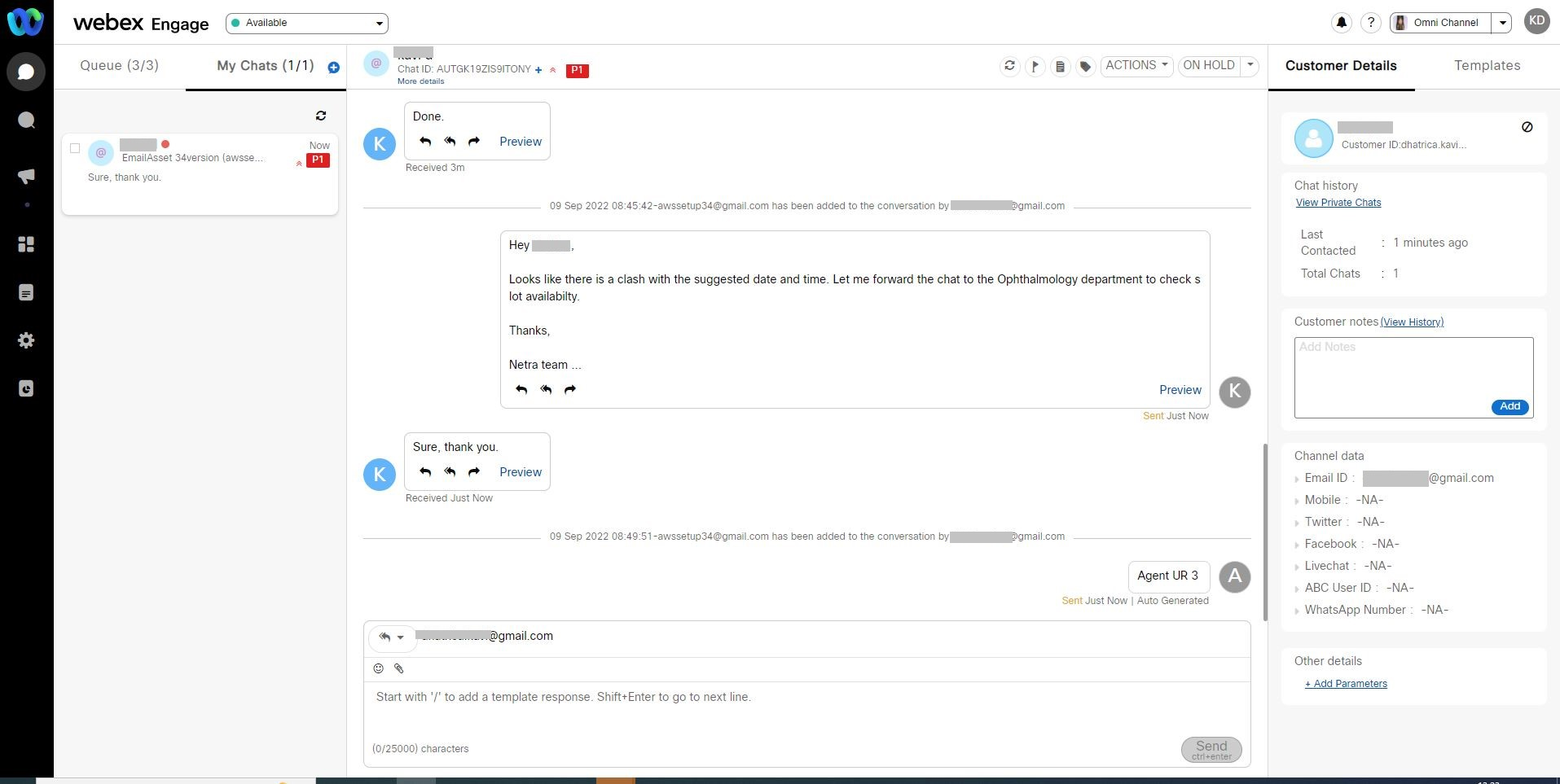
The following pop-up window appears on the screen.
- Select an email asset from the list and click Forward.
A success message appears on the screen.
The existing chat will automatically close with an outcome Internally Forwarded and an announcement will log in to the chat thread.
After a successful redirect activity, the chat lands in the Queue of the default team configured for the redirected asset. A priority gets allocated to this chat as per the asset configuration.
To initiate a transferred conversation,
• An agent must manually pick the chat (or)
• A chat must be manually assigned to an agent (or)
• A chat can be automatically assigned to an agent when the Auto Assign to Agents setting is turned ON in the Case Settings for the default team.
When the chat is picked from the Queue, agents can view an announcement in the chat thread. This announcement contains the previous chat id.
Note
The old chat will reopen if the customer responds on the old thread rather than the forwarded email thread.
Forward Emails With Attachments
You can forward an email along with the list of attachments available in the latest inbound message (MO). You can send only selected attachments and delete the rest while forwarding an email by clicking the x icon beside each of them.
Note
During email forward, Webex Engage will load the last incoming (MO) text with attachment messages supported on the chat console. The Webex Engage will not load the messages even if a single attachment file format is not supported on the chat console.
Message Box
Webex Engage provides an intuitive auto expandable message box for the agents to chat with customers. The message box expands automatically up to 15 lines beyond which a scroll bar appears on the message box.

The following features are accessible through the message box:
Emojis Support
Webex Engage enables agents to use emojis (emoticons) within the chat conversation. Agents can view the emojis that are configured at tenant level by the client admin.
An emoji is a combination of characters that renders as a picture and helps one to express better.
Agents can select from the list of emojis by clicking on the icon on top of the message box.
If emojis are not enabled for a tenant, the agents of that tenant will not view emojis on the Chat Console

Note:
- Webex Engage will support emojis only on Internet Explorer (IE) 12 and above.
- By default, emojis are enabled for all the tenants and the same configured set of emojis are applicable for Chat Console and Feed (social listening) replies for a tenant.
Attachments Support
Agents and Customers can send attachments to each other through chats. Webex Engage supports attachments on Facebook, LiveChat, Email, API/Generic, Apple Messages for Business, and WhatsApp channels. Agents can send attachments only in the formats configured at tenant level by the client admin.
Follow these steps to add an attachment:
- Click Attachment icon on the top of the message box.
- Browse through the files from the device and select a file.
- The file is loaded into the message box along with a loading indicator for agents to know the file loading status.
- The agents can choose to either cancel the attachment using cross icon within the attachment or can send the attachment using the Send button.
Note:
To send an attachment, an agent should enter text along with the attachment. If the agent tries to send an attachment without any supporting text, an alert message is displayed to the agent on all the digital channels except LiveChat and Apple Messages for Business channels.

Text Formatting
Text formatting makes agent responses easier to read and understand. Webex Engage allows agents to add bold, italics and underline on the responses sent on Email channel.
To apply text formatting, agent can use the formatting tab on the top of the message box.

Note
Text formatting is supported only on Email channel.
Keyboard Shortcuts
Keyboard shortcuts allow agents to perform repetitive tasks quickly and improve their productivity. Webex Engage supports keyboard shortcuts for below actions:
Loading a Template
Agents can load templates by typing forward slash (/) in the message box. It also loads the list of templates that have been configured for the channel. The agent can search and choose a template from the list of templates.
For detailed information about using templates please visit the section Templates .
Sending a Message
Sending a message is a repetitive action for agents. The agents can use the keyboard shortcut Ctrl + Enter to quickly message the customers.
System Params in the Templates
The client admins and team managers can configure system parameters in the templates. When an agent uses such templates in the conversations the corresponding values are dynamically substituted in the chat.

Note:
In cases where a customer has multiple entries mapped to the mobile number and/or email address, the last contacted mobile number and/or email address is picked up for substitution when the template is used.
If the relevant data is not available for the parameters passed in the template, the variable portion is highlighted, and the agent must manually substitute or remove it before sending the message to the end user.
Close a Chat
The team manager can close a chat session with a customer if required. This will completely remove the chat session from the console. If the customer replies after closing the chat, a new chat (new chat ID) is created for the customer. The details of the chat will be available through the reports section.
Follow these steps to close a chat:
- Click On Hold drop-down and select Close. A popup window is displayed.
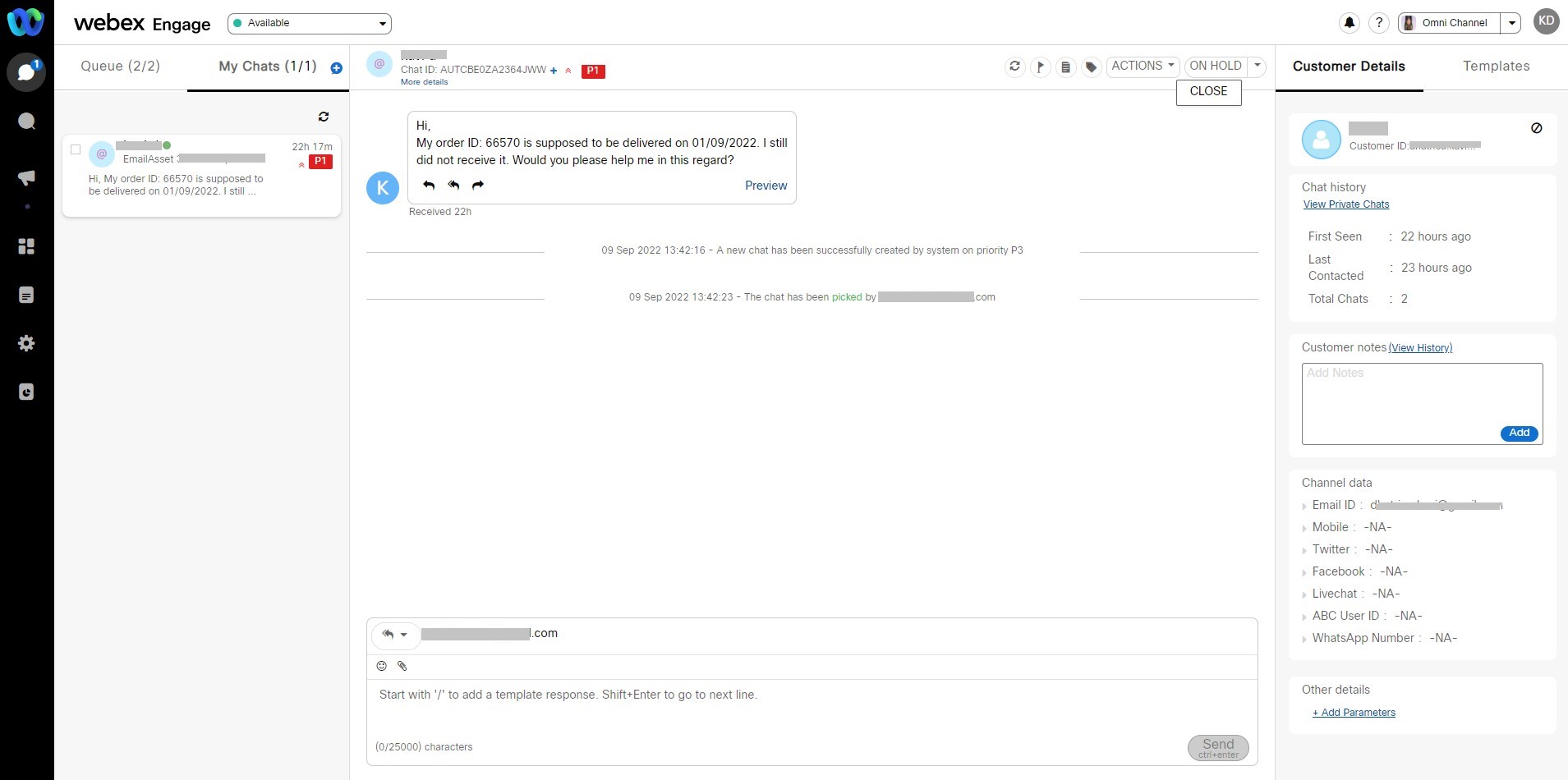
- Select a Chat Outcome from the drop-down list.
This field can be disabled by the team manager under Settings > Configure > Chat Outcome if needed.
- Complete the assigned agent survey by selecting the required checkboxes and clicking Submit and Close Chat.
- Click Skip and Close Chat to skip a survey.
You will view the Skip and Chose Chat option if the administrator has enabled it while configuring an asset.
Map Preview
Webex Engage allows Agents to view Location Messages sent by the customer. These messages can be viewed as Map Preview on the Chat Console. On clicking the card, agents are re-directed to google maps with the marked location.
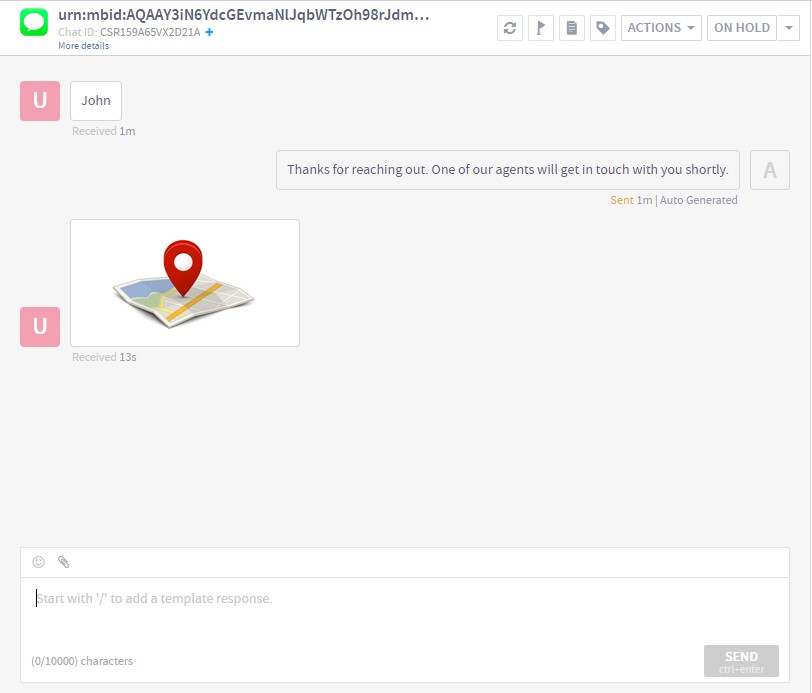
Floating Button
Webex Engage allows its agents to read the conversations seamlessly without any disturbance. When a message arrives while reading a conversation, a New Messages floating button appears on the screen. An agent can click on the floating button to view the message or ignore to continue reading the conversations.
Network Connectivity Visual Indicator
Webex Engage application allows its agents to view network interruption message on the Chat Console whenever there is a disruption. The application will perform Three automatic retries. Still, if the network is not established, the application will throw an error message, prompting the users to attempt a manual retry.
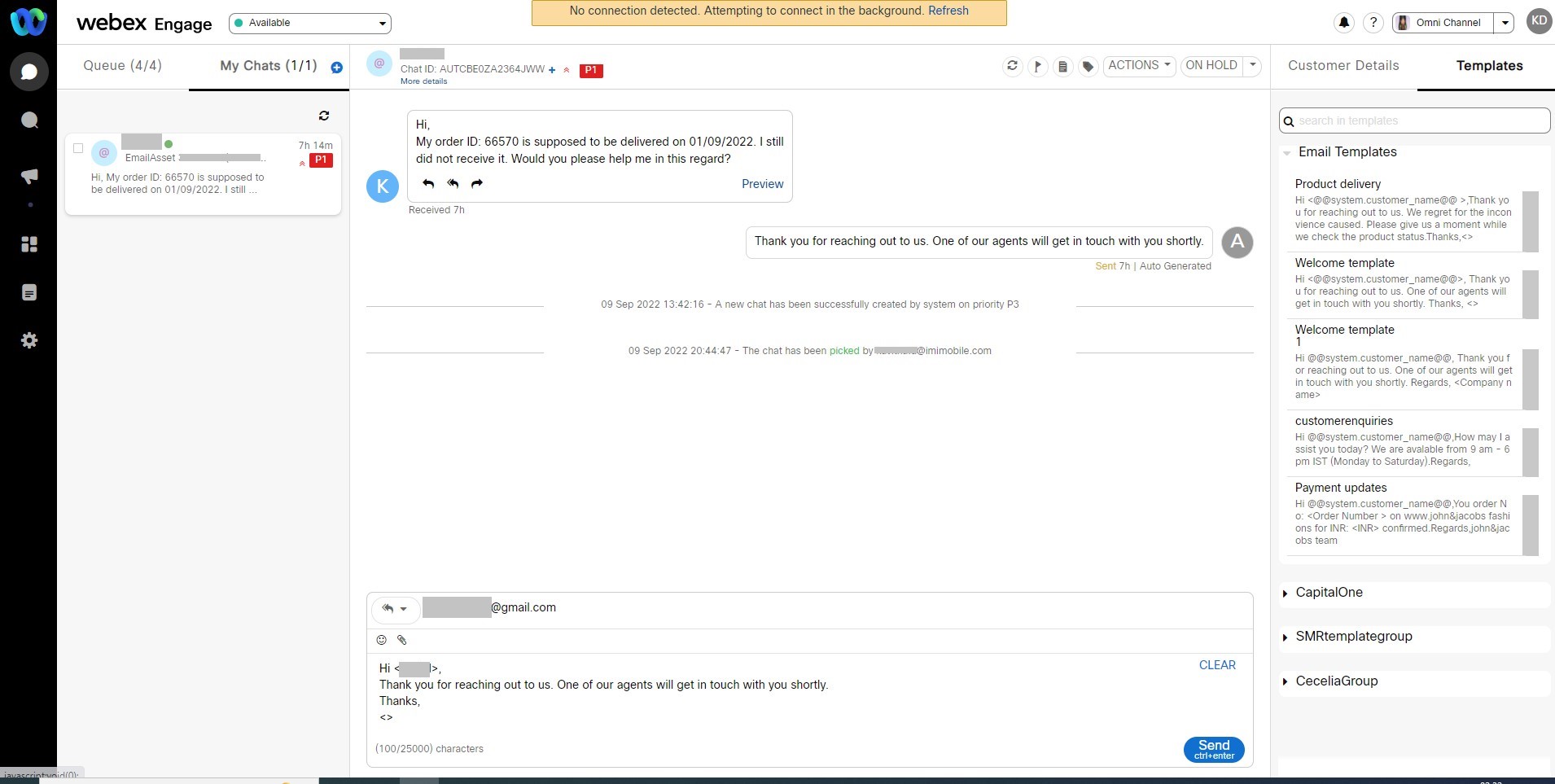
Agents can click on the manual retry button to establish the connection. The application will display Attempting to Connect message and enters into overlay mode restricting agents to perform any operation. If a connection is established, a success message appears on the screen. Otherwise, the cycle continues.
End Customers Weak Internet Connection Visual Indicator on the Chat Consoles
The visual indicators on the chat console warn the agents about the network connectivity issues at the customers' end.
When the customer has a weak internet connection during a live chat conversation, you can view a weak internet connection visual indicator with a warning symbol on the live chat icon in the My Chats section and above the conversation pane on the chat console. A banner message Looks like customer's internet connection is weak. There might be delays/failures while sending and receiving the messages. will display above the message composer.

Carbon Copy (CC) and Forwards on Email Channel
The agents on Webex Engage can send Carbon Copy (CC) or Forwards or Reply to multiple email ids (reply all) from the chat console.
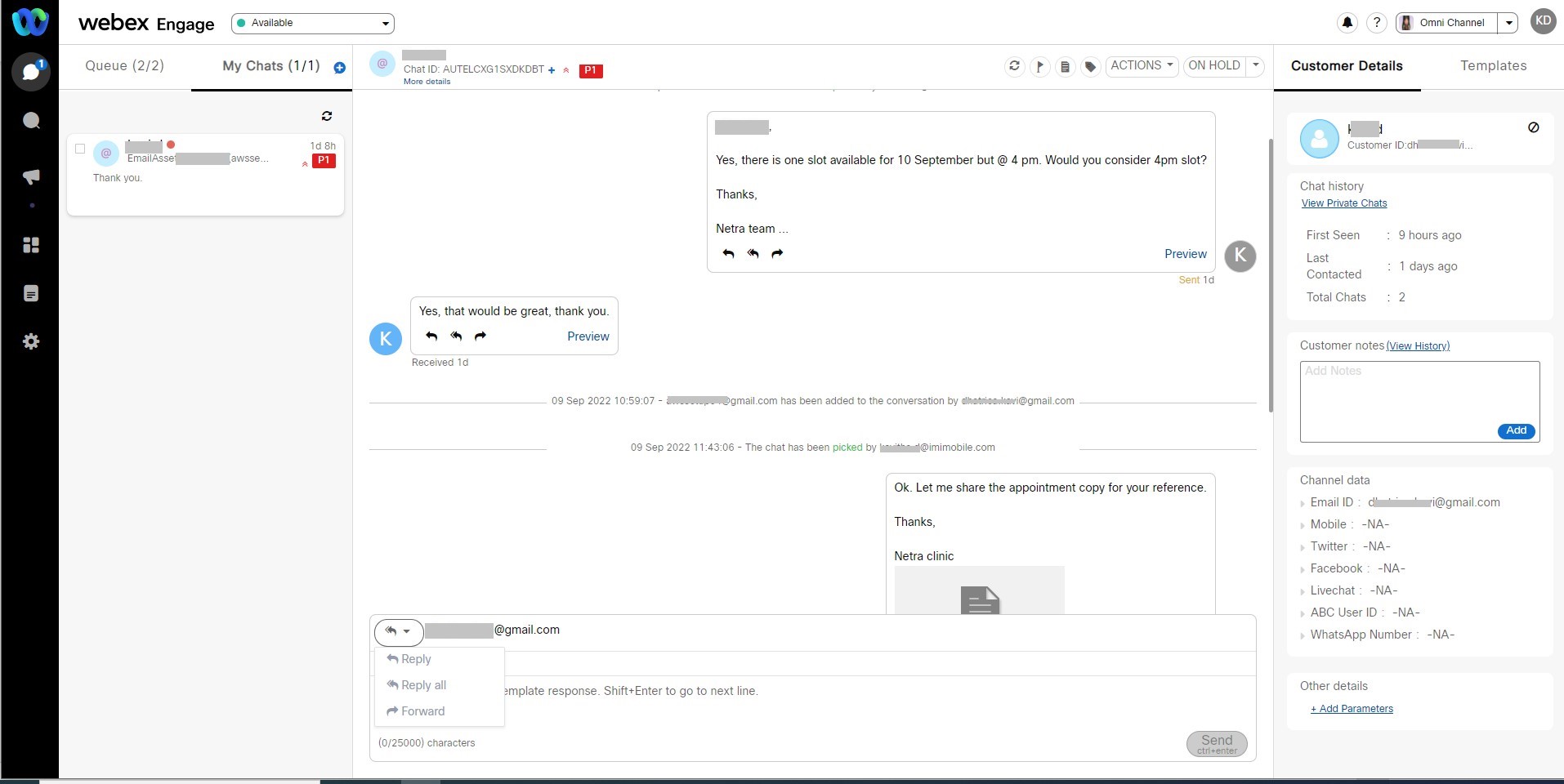
Customers can also initiate chats over email by including other recipients in CC and Webex Engage agents will have full visibility into all such details on the agent console.
When multiple participants are involved in a message as in the case of email, all the participants in FROM, TO, and CC(if any) are shown. To quickly identify messages involving multiple participants the signature bubble for such messages the application displays a small ‘+CC’ badge on the bottom-right-corner as shown below.
Additionally, agents can choose to reply, reply all, and forward to a specific message from the conversation by clicking the respective icon beneath each message in the chat thread.
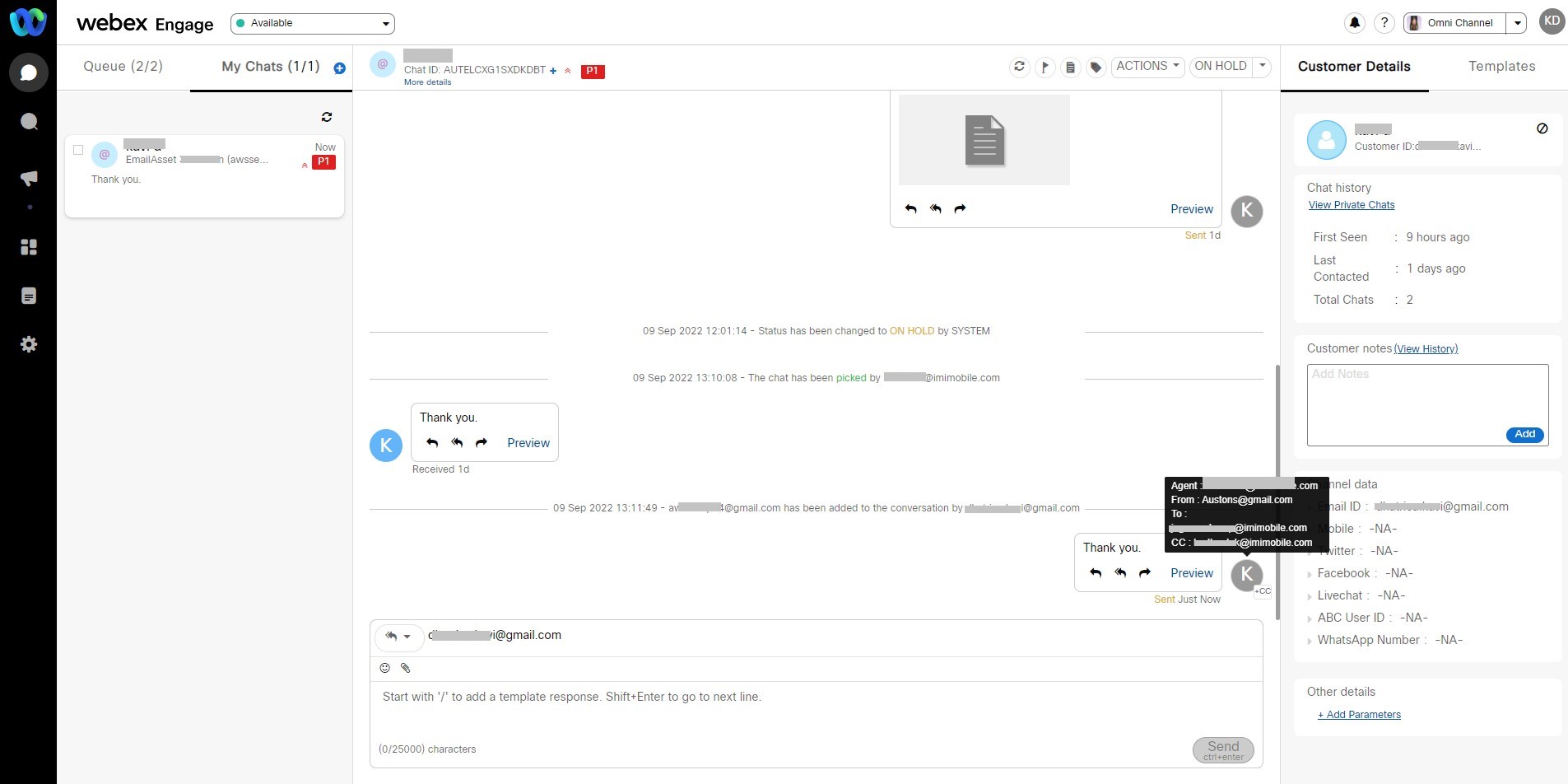
To make it more comprehensive on email channel, the following additional events are added to the announcement set:
• When a new email recipient is added to a conversation
• When an email recipient is removed from a conversation
Further, agents can click on the preview button available at the end of the message to view the chat thread in a separate window.
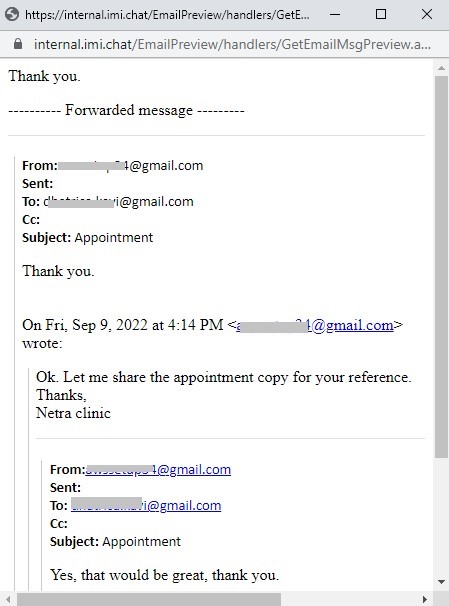
The following scenarios will give you insights into how the certain scenarios are handled on email channel
| Scenario | Description |
|---|---|
| Customer sends an inbound email with CC emails ids | Webex Engage will create a new chat by adding all the receipt email ids to the CC list by maintaining primary email id (From) constant. |
| Agent sends reply to all the email ids | Webex Engage will send the email to all the email recipients. |
| When a user in CC email id replies to the email thread | Webex Engage will append such email to the existing chat thread. |
| When an agent forwards an email to any external email id | Webex Engage will send the email to the forward email id along with chat history if enable chat history on agent replies setting is enabled. |
| When a user in forward email id replies to the message | Such emails will be appended to the existing chat thread. |
| When a user in CC/Forward email id adds/removes external email id to the conversation | Such email ids will be added/removed from the existing email thread based on the action performed. |
Note:
Agents can view the CC's and Forward email id's on the chat console if Add Recipient To Email Conversation setting is enabled by the client admins.
To maintain a unique chat thread, agents on Webex Engage do not have permission to change the ‘SUBJECT’ and ‘TO’ email id in a conversation.
Today we have a provision to auto-save the customer name and create a profile based on the information received from the email service provider.
There are scenarios when the underlying email gateway does not provide a sender’s name along with the email address. In such cases the email address will be duplicated in the name field when creating a customer profile for that sender.
All external recipients added to an email conversation (in CC, or TO fields) will have customer profiles automatically created for them by the system.
Session Timeout Alert on the Chat Console
The session timeout alert warns the users about the session timeout one minute before the configured auto timeout duration.
When the configured auto timeout session is about to expire, you will view an alert message with a timer one minute before the configured session expiry duration on the chat console. For example, if the administrator sets the auto timeout value to 15mins, the timer will display at the 14th minute on the chat console. When the session timeout is reached, the application prompts whether to Log Out or Continue working. If you don't respond to this prompt, you will be logged out of the application. You can extend the session by clicking the Continue button. A message Your session was successfully extended will appear on the screen.
Updated about 3 years ago
